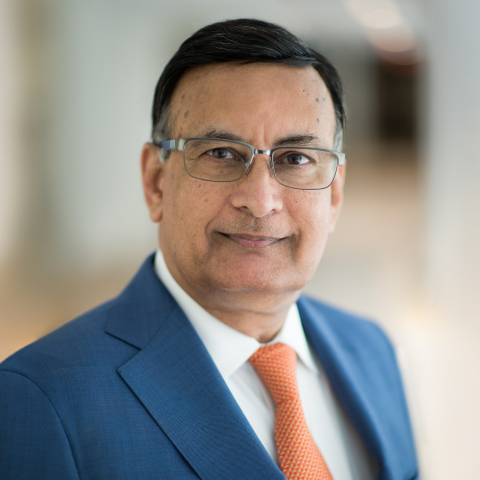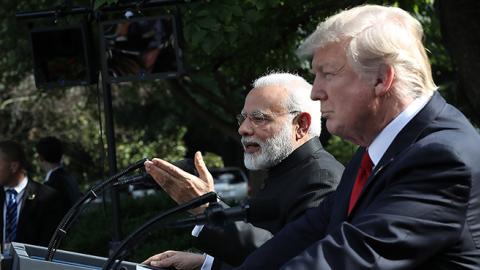The meeting this week between President Trump and Indian prime minister Narendra Modi could be one of the most important of the Trump presidency. Certainly the time is ripe for a major transformation of U.S.–Indian relations, and both Modi and Trump are uniquely positioned to bring it about. They must overcome domestic political distractions to forge what could be a defining partnership for the next century.
Both men are deeply committed to the interests of their countries, and both see the need to expand the economic opportunities that flow from modern post-industrial growth (in India’s case, estimated to be almost 7.5 percent this year) to the entire society. Both also lead countries that share many of the common cultural characteristics of the Anglosphere, including the English language and a belief in the rule of law and constitutional democracy. Both countries combine rich ethnic and religious diversity with a strong sense of national pride.
The U.S. and India also confront similar challenges on the international front. Both face the daily threat of Islamist terrorism, with the horrors of 9/11 and the attacks in San Bernardino and Orlando paralleled by the deadly assault in Mumbai in 2008 that killed or injured more than 500 people, including several Americans. The terrorists who threaten both countries also share a sanctuary — namely, Pakistan — that has provided safe haven for groups responsible for terrorist strikes in India as well as for attacks on U.S. soldiers in Afghanistan.
Both also confront the rise of an aggressive, militarized China. Beijing’s efforts to push the U.S. Navy out of the East China and South China Seas are matched by its growing geopolitical presence in the Indian Ocean. In addition to massing formidable military forces on its common border with India, China has plans for a major naval base at Gwadar, Pakistan, which would bring it to the doorstep of the Persian Gulf. China’s multi-billion-dollar infrastructure projects in Pakistan, part of the “One Belt, One Road” initiative, also expand China’s reach to India’s western doorstep.
Fortunately, Prime Minister Modi fully understands the extent of the China challenge and the importance of the U.S. strategic partnership as a counterbalance. Now it’s time for the U.S. to step up and assume the role of partner and guide.
The first step would be to encourage more energy trade and cooperation, so that the U.S.’s new oil and natural-gas export boom can flow directly to the benefit of India. Differences over trade deficits and the Trans-Pacific Partnership (TPP) have masked both countries’ interest in increasing the bilateral trade of energy. India would much rather get its oil and natural gas from the United States than from Russia and Iran, while India’s own rich natural energy resources, including its shale-gas reserves, could benefit from cooperation with U.S. energy companies.
The second step is more direct U.S.–India defense trade and industrial cooperation. For decades the Indian military has bought its weapons from Russia and France, but its latest round of purchases from Moscow, including the Sukhoi T-50 stealth fighter, have been less than satisfactory. While India is not going to be acquiring advanced systems like the Joint Strike Fighter anytime soon, the administration should be facilitating India’s acquisition of other U.S. defense hardware — for example, unmanned aerial vehicles — and looking for ways to cooperate in areas such as shipbuilding.
Third, the United States already supports a permanent seat for India on the United Nations Security Council, and the Trump administration should actively push for it. As the world’s second-most-populous nation, with the second-largest army, the fourth-largest air force, and the seventh-largest navy — as well as the fourth-fastest-growing economy — India clearly deserves a place at the Security Council table, as President Obama clearly recognized when he raised the issue in 2010.
The fourth step is for the U.S. to encourage more trilateral strategic cooperation with Japan. In 2015 Japan was invited to join the U.S. and India in the Malabar joint naval exercises for the first time; now it should be a regular event. President Trump should also continue the trilateral strategic dialogue inaugurated in 2011. He can take full advantage of the strong relationship he has built with Japanese prime minister Shinzo Abe, and of the friendship that has grown up between Abe and Modi, to shape a robust three-way alliance that can oversee the security environment in the entire Indo-Pacific region.
Most important, both leaders must recognize the need for an architecture for security in the Indo-Pacific region. Just as the threat of Soviet dominance led to the Atlantic partnership that shaped the post–World War II world, China’s desire to hold sway over the Indo-Pacific should bring together the region’s major democracies — Australia, Japan, and South Korea, in addition to India and the U.S.
To build a stronger partnership, Mr. Modi would have to surmount the Indian bureaucracy’s fascination with an overregulated economy and the traditional professions of non-alignment in international affairs. He would also have to ensure that enthusiasm for cultural issues, such as protection of cows and exclusion of religious minorities, does not disrupt India’s process of economic reform.
Mr. Trump, on the other hand, would have to overcome the tendency (dating back to the Cold War era) of U.S. officials to wade into India–Pakistan disagreements at Pakistan’s behest. That should not preclude the U.S.’s playing the role, at the right time, of an “honest broker” in helping to defuse India–Pakistan tensions — especially when those tensions could turn that particular front in the War on Terror into a nuclear confrontation.
For decades, relations between India and the United States have been fraught with tension and misunderstanding, and opportunities for partnership between the world’s two biggest democracies have been allowed to slip away. Today, the Indo-Pacific region cannot afford another missed opportunity. For President Trump and Prime Minister Modi, this may be the moment for creating a new era of security and stability in Asia.
















